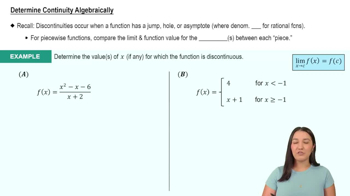Table of contents
- 0. Functions7h 52m
- Introduction to Functions16m
- Piecewise Functions10m
- Properties of Functions9m
- Common Functions1h 8m
- Transformations5m
- Combining Functions27m
- Exponent rules32m
- Exponential Functions28m
- Logarithmic Functions24m
- Properties of Logarithms34m
- Exponential & Logarithmic Equations35m
- Introduction to Trigonometric Functions38m
- Graphs of Trigonometric Functions44m
- Trigonometric Identities47m
- Inverse Trigonometric Functions48m
- 1. Limits and Continuity2h 2m
- 2. Intro to Derivatives1h 33m
- 3. Techniques of Differentiation3h 18m
- 4. Applications of Derivatives2h 38m
- 5. Graphical Applications of Derivatives6h 2m
- 6. Derivatives of Inverse, Exponential, & Logarithmic Functions2h 37m
- 7. Antiderivatives & Indefinite Integrals1h 26m
- 8. Definite Integrals4h 44m
- 9. Graphical Applications of Integrals2h 27m
- 10. Physics Applications of Integrals 2h 22m
1. Limits and Continuity
Finding Limits Algebraically
Problem 50a
Textbook Question
Evaluate each limit.
lim x→−1 (x^2−4+ 3√x^2−9)
 Verified step by step guidance
Verified step by step guidance1
Step 1: Identify the form of the limit as x approaches -1. Substitute x = -1 into the expression x^2 - 4 + 3\sqrt{x^2 - 9} to check if it results in an indeterminate form.
Step 2: Simplify the expression. Notice that x^2 - 4 is a polynomial and 3\sqrt{x^2 - 9} is a radical expression. Simplify each part separately.
Step 3: Substitute x = -1 into the simplified expression. Calculate x^2 - 4 and 3\sqrt{x^2 - 9} separately to see if the limit can be directly evaluated.
Step 4: If direct substitution results in an indeterminate form, consider using algebraic manipulation or L'Hôpital's Rule if applicable. Check if the expression can be factored or simplified further.
Step 5: Evaluate the limit using the simplified expression or the result from L'Hôpital's Rule. Ensure that the final expression is not indeterminate and provides a clear value for the limit.
 Verified video answer for a similar problem:
Verified video answer for a similar problem:This video solution was recommended by our tutors as helpful for the problem above
Video duration:
1mPlay a video:
Was this helpful?
Key Concepts
Here are the essential concepts you must grasp in order to answer the question correctly.
Limits
A limit is a fundamental concept in calculus that describes the behavior of a function as its input approaches a certain value. It helps in understanding how functions behave near points of interest, including points of discontinuity or infinity. Evaluating limits often involves substituting values directly into the function, but sometimes requires algebraic manipulation or special techniques when direct substitution leads to indeterminate forms.
Recommended video:

One-Sided Limits
Continuous Functions
A function is continuous at a point if the limit of the function as it approaches that point equals the function's value at that point. This concept is crucial when evaluating limits, as continuous functions allow for straightforward substitution. If a function is not continuous at a point, special techniques such as factoring or using L'Hôpital's rule may be necessary to evaluate the limit.
Recommended video:

Intro to Continuity
Algebraic Manipulation
Algebraic manipulation involves rearranging and simplifying expressions to facilitate limit evaluation. This can include factoring polynomials, rationalizing expressions, or combining like terms. In the context of limits, these techniques help resolve indeterminate forms, making it possible to find the limit by transforming the expression into a more manageable form.
Recommended video:

Determine Continuity Algebraically

 5:21m
5:21mWatch next
Master Finding Limits by Direct Substitution with a bite sized video explanation from Callie
Start learningRelated Videos
Related Practice







